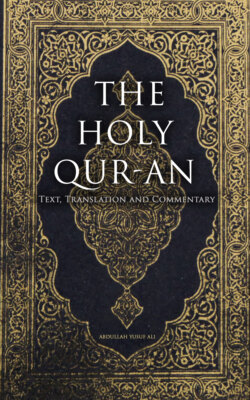Читать книгу The Holy Qur-an: Text, Translation and Commentary - Abdullah Yusuf Ali - Страница 10
На сайте Литреса книга снята с продажи.
Divisions Of The Qur'an
ОглавлениеTable of Contents
The reading of the Qur’an is considered a pious duty by every Muslim and is actually performed in practice by every literate person, man woman, and child. For the convenience of those who wish to complete the whole reading in a given time, the whole Text is divided into thirty equal parts, or seven equal parts. The thirtieth Part is called Sipaha or simply Para in Persian and Urdu. If you read a Sipaha every day, you complete the whole reading in a month of thirty days. The seventh part is called a Manzil. If one is read every day, the whole is completed in a week. Usually the arithmetical quarters of a Sipaha (one-fourth, one-half, three quarters) are also marked in the Arabic copies as Ar-rub’, An-nisf, and Ath-thalatha.
According to subject-matter, the division is different. The whole of the Qur’an is arranged in 114 Surahs of very unequal size. The Surahs are numbered and the consecutive number is shown just before the title of the Surah, both in Arabic and English. In Arabic, the figure just after the title shows the chronological order as usually accepted by Muslims writers. Each Surah consists of a number of Ayats. Surah 1 contains 7 Ayats and Surah 2 contains 286. For the meaning of Surah and Ayat see C. 42 nn. 15-17. The most convenient form of quotation is to name the Surah and the Ayat: thus 2:120 means the 120th Ayat of the second Surah. A Surah is usually spoken of as a Chapter in English, but that translation is hardly satisfactory. If you examine the order you will find that each Surah is a step in a gradation. I have left the word untranslated, as a technical term in our religious literature. The Ayat or verse division is usually determined by the rhythm and cadence in the Arabic Text. Sometimes an Ayat contains many sentences. Sometimes a sentence is divided by a break in an Ayat. But usually there is a pause in meaning at the end of an Ayat.
A division of the Surah into Sections is shown in all Arabic Text. These are logical divisions according to meaning. The word translated “Section” is in Arabic Ruku’ a “bowing of the head.” The end of a Ruku’ is shown in Arabic by [character not included]. Usually three figures are written with ﻉ. The top figure shows the numner of Ruku’s completed in that Surah. The middle figure shows the number of Ayats in the Ruku just completed. The bottom figure shows the number of Ruku’s completed in that Sipara, irrespective of Surahs. For example, the first ﻉ in Sipara 2 which continues Surah 2 from Sipara 1 is usually marked [character not included]. It means that at that point 17 Ruku’s of Surah 2 have been completed, that the Ruku’ of which it marks the close contains 6 Ayats, and that it is the first Ruku’ that falls in Sipara 2. I have further marked the sub-division of Ruku’s into shorter paragraphs where necessary, by using in the English text a bold flowery Initial; e.g. see the initial [Initial not included] in 2:6 or the initial [Initial not included] in 2:35.
